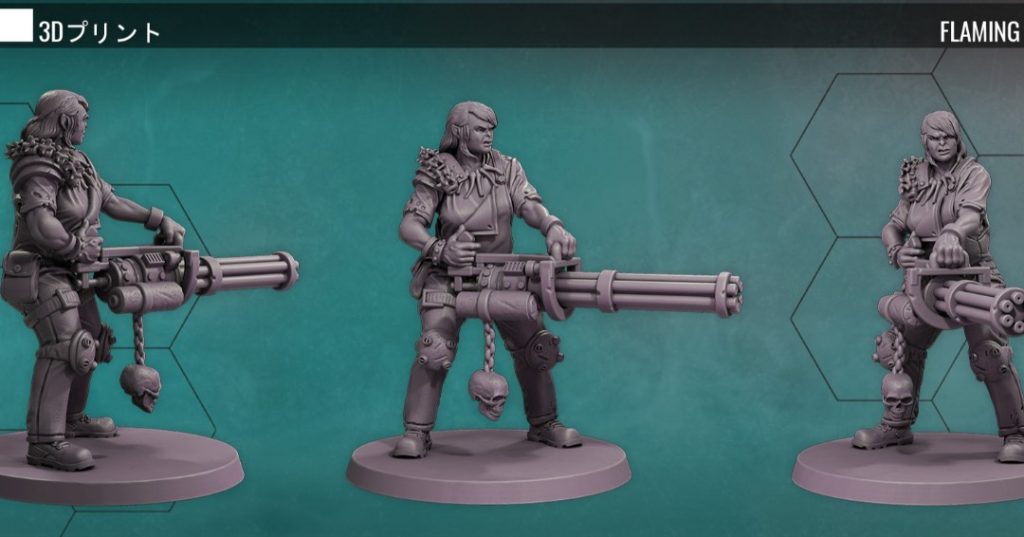Fragging Unicorn Talk The Basics Of Gangs Of The Undercity
January 21, 2020 by brennon
Fragging Unicorn Games have been showing off more previews of what awaits for Gangs Of The Undercity plus they have also been delving into some of the basics you need to know about the game they have planned.
First up we're looking at a cool new miniature that was previewed over on Facebook. This is Snapper who is an Ogre and member of the Flaming Skulls gang. She is a hefty model and as you can see has a love of equally hefty weapons too!
She is just one of the miniatures you'll be able to pick up when the game launches. As we mentioned in our previous look at the game, you will either be able to pick up a pre-made gang and follow their story or perhaps jump in and do something unique of your own.
Gangs Of The Undercity Basics
At the heart of it, the game of Gangs Of The Undercity is a skirmisher which draws influences from the likes of Shadowrun but also classics like Necromunda and Mordheim. You will take on the role of a gang as part of a campaign who is vying for control of a Cyberpunk-inspired city.
Games will feature lots of terrain elements, small and unique gangs and a massive dose of Fantasy as you'll have seen with Elves, Dwarves, Orcs, Goblins, Ogres and more being thrown into the mix alongside a little bit of magic for good measure. Here is what they listed as some of the cool options they have in the works...
- Make sure gangs, models, gear, and abilities are well-balanced. We want a competitive game, not just something to sell minis.
- About six or seven models in a gang. Should be a game where hobbyists can spend as much as they want, but the point of entry should be low enough a kid can get it for Christmas.
- Honour traditional wargamers. If there is something wargaming does now, and there’s no reason to change it, let’s keep it. Example: 25mm base sizes, and 28mm Heroic scale minis, are pretty standard for D&D, unmodified humans in 40k, Reaper minis, etc, so by keeping our models in the same scale, we allow mixes and matches. Let our terrain and minis fit wherever our players want them to, let’s not be different just to be different.
- About an hour per game. It's ok if it takes longer while learning, but in a tournament or between friends who know the game, an hour should do.
- Build in the possibility of progression. Build the game in such a way that multiple game style tournaments/campaigns are common, and minis grow in power and status along the way.
- Work with the best sculptor(s) and manufacturers. We want to see these minis painted and winning awards. We aren’t just into getting a piece of plastic on a table. In fact, do everything-art, minis, writing, playtesting, ethics - to the best of our ability.
This all sounds very cool indeed and I am very much looking forward to learning more about the game and how it plays in general as the weeks roll on. Any game which features a LOT of terrain, a narrative focus and plenty of opportunities to get excited about varied paint schemes works for me.
What do you think about what we've learned this week?
"Any game which features a LOT of terrain, a narrative focus and plenty of opportunities to get excited about varied paint schemes works for me..."
Supported by (Turn Off)
Supported by (Turn Off)
Supported by (Turn Off)































![How To Paint Moonstone’s Nanny | Goblin King Games [7 Days Early Access]](https://images.beastsofwar.com/2024/12/3CU-Gobin-King-Games-Moonstone-Shades-Nanny-coverimage-225-127.jpg)










































As hello to my big friend.
I gotta say, as excited as I am for this game, that model is ticking precisely zero boxes for me. First, if its an Ogre, she’s not ugly enough. Where’s the underbite, tusk like teeth etc. I would also say that she is perhaps too lithe. Broadly speaking, and with nothing to use as a comparator, she just looks like an Elf. Which lead to my second criticism – She also doesn’t look female elf. While people may laud how sensible she looks, the Cyberpunk Genre is all about looking cool doing whatever it is you are doing; style over… Read more »
Every world has different variations on the fantasy races, and ours is no different. Having said that, It isn’t too late to change the sculpts and you may be onto something with the tusk-like teeth and more feral appearance. i don’t think ugly is what we’re gonna go with, but maybe something less smooth. hmm. Thanks for the input!
I totally get that but at the same time, owing to the fact that many of these fantasy races come from historical traditions and myths, there are some expectations around them – one being that Ogres will be big and ugly to human eyes (I am sure they all look very nice to other Ogres) or at least have traits that we would consider ugly. That doesn’t necessarily mean that they can’t look smart, stylish, dapper, cool or any other look (you could stick an Ogre in a ball gown or a Tux no worries). There’s definitely a balance to… Read more »
Is this going to be one book with all the factions in it and/or a starter set?
I suspect it will be one book to start with.
We are looking to make a starter set initially, with perhaps add-ons based on the level of KS support.
Thanks. Looking forward to the Kickstarter.